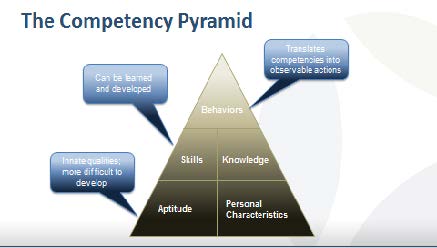Why Competency Modeling Matters In Leadership Development
If you judge a fish by its ability to climb a tree, it will live its whole life believing it is stupid.
Albert Einstein
Hiring, promoting and evaluating people based on their natural strengths, expertise and ability to perform the job for which they were hired seems like common sense, but all too often, companies don’t define this clearly enough. You’ve probably read a fair share of vague job descriptions calling for a leader or manager who “takes initiative,” is a “critical thinker” and who can “motivate a team to excel.”
While these qualities are important, this could describe virtually any leader. If this is the main criteria for hiring or promoting leaders within your company, you’re likely going to see mixed results.
How can you define and objectively assess the characteristics that matter most among your leadership?
The secret is to develop and deploy competency modeling — the foundation of every leadership development program.
Competency modeling provides a precise definition of the skills and attributes needed to meet critical business challenges. Rather than being a vague wish list, they define observable, measurable behaviors. Although behaviors are easiest to see and modify, they are just the tip of the pyramid.
Behaviors are directly influenced by skills and knowledge, which take time to develop. Skills and knowledge can be shaped by a leader’s aptitude to learn and personal characteristics, which are innate and more difficult to develop. This is where competency modeling comes into play.

Here are three reasons why competency models matter in leadership development.
They Help Us Align Behavior With Culture and Strategy and Adapt to Change
Cultural fit is often described as the glue that holds an organization together. Southwest Airlines has built a unique culture by unabashedly stating it puts employees first, customers second and shareholders third. In many ways, it has turned the traditional model on its head. And it has good reason to—customer service is at the very heart of what makes any airline successful.
“We believe that if we treat our employees right, they will treat our customers right, and in turn that results in increased business and profits that make everyone happy,” the airline states in a blog post about its culture.
Maintaining this culture is a business strategy in itself, and it doesn’t happen by accident. It starts by defining a set of core values, as Southwest has done on its careers page. Those values include a warrior spirit, a servant’s heart, a fun-LUVing attitude and working the “Southwest Way.” Each value has a corresponding set of behaviors HR professionals use when hiring and managers use for promoting and evaluating performance.
They Help Us Give Useful Feedback
Imagine you’ve been at a new job for a few months and feeling you’re doing your absolute best work. Unfortunately your boss doesn’t see it that way, and at your 90-day review, she warns you to “step your game up.” That’s it. You might as well start looking for a new position, because there’s no way you can improve without knowing where you’re falling short.
In a more constructive performance evaluation, your boss should be able to point to specific instances where you failed to meet a defined set of expectations or where she sees room for improvement. Perhaps you’re great at getting things done on your own, but you rarely seek input from the rest of the team or delegate when you should. If your boss has defined teamwork as a critical competency, then she can’t argue you didn’t know it was important.
They Help Us Invest In Training And Development Activities That Have The Greatest Impact
When it comes to training and development, almost every company faces the same constraints: time and money.
You only have so many dollars allotted for leadership development, so it’s in everyone’s best interest to focus on developing the skills that are most clearly needed. Unless you have taken the time to define what success looks like for each leadership position and how you will measure it, you can’t accurately assess each leader’s strengths and opportunities for growth.
By contrast, building a strong leadership pipeline is much easier when you have a clearly defined set of competency models. Justine Staub, Director of Workforce Development at AmeriGas, quickly discovered this when she began developing a succession management program for her company’s Area Directors. Before she could create a meaningful training program to help them excel, she realized she had to take a step back and define exactly what they needed to succeed in their position.
Now that the program is rooted in a defined set of competencies, it’s much easier for Staub to identify which employees should be considered potential Area Directors. Employees also have more clarity over what they need to do in order to advance, which has boosted retention and morale within the company.
The Bottom Line
Unless your company has clearly defined what success looks like, especially for your leaders, it will be difficult to determine when someone has achieved it. Your processes for hiring and promoting top talent will be inherently subjective, and results will vary.
If you’re ready to get serious about developing meaningful success factors to shape your succession management and leadership development, join me for an upcoming webinar on competency modeling at noon EST Thursday, June 23. We’ll discuss how to incorporate them into your existing processes and best practices for using them well. Space is limited, so register today.



